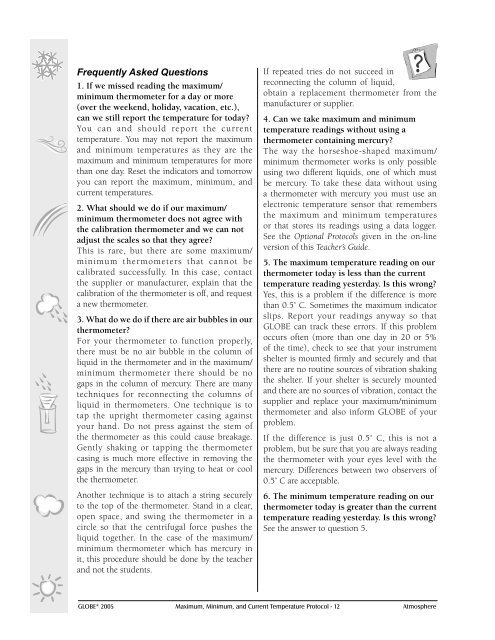Maximum, Minimum, and Current Temperature Protocol - GLOBE
Maximum, Minimum, and Current Temperature Protocol - GLOBE
Maximum, Minimum, and Current Temperature Protocol - GLOBE
You also want an ePaper? Increase the reach of your titles
YUMPU automatically turns print PDFs into web optimized ePapers that Google loves.
Frequently Asked Questions<br />
1. If we missed reading the maximum/<br />
minimum thermometer for a day or more<br />
(over the weekend, holiday, vacation, etc.),<br />
can we still report the temperature for today?<br />
You can <strong>and</strong> should report the current<br />
temperature. You may not report the maximum<br />
<strong>and</strong> minimum temperatures as they are the<br />
maximum <strong>and</strong> minimum temperatures for more<br />
than one day. Reset the indicators <strong>and</strong> tomorrow<br />
you can report the maximum, minimum, <strong>and</strong><br />
current temperatures.<br />
2. What should we do if our maximum/<br />
minimum thermometer does not agree with<br />
the calibration thermometer <strong>and</strong> we can not<br />
adjust the scales so that they agree?<br />
This is rare, but there are some maximum/<br />
minimum thermometers that cannot be<br />
calibrated successfully. In this case, contact<br />
the supplier or manufacturer, explain that the<br />
calibration of the thermometer is off, <strong>and</strong> request<br />
a new thermometer.<br />
3. What do we do if there are air bubbles in our<br />
thermometer?<br />
For your thermometer to function properly,<br />
there must be no air bubble in the column of<br />
liquid in the thermometer <strong>and</strong> in the maximum/<br />
minimum thermometer there should be no<br />
gaps in the column of mercury. There are many<br />
techniques for reconnecting the columns of<br />
liquid in thermometers. One technique is to<br />
tap the upright thermometer casing against<br />
your h<strong>and</strong>. Do not press against the stem of<br />
the thermometer as this could cause breakage.<br />
Gently shaking or tapping the thermometer<br />
casing is much more effective in removing the<br />
gaps in the mercury than trying to heat or cool<br />
the thermometer.<br />
Another technique is to attach a string securely<br />
to the top of the thermometer. St<strong>and</strong> in a clear,<br />
open space, <strong>and</strong> swing the thermometer in a<br />
circle so that the centrifugal force pushes the<br />
liquid together. In the case of the maximum/<br />
minimum thermometer which has mercury in<br />
it, this procedure should be done by the teacher<br />
<strong>and</strong> not the students.<br />
If repeated tries do not succeed in<br />
reconnecting the column of liquid,<br />
obtain a replacement thermometer from the<br />
manufacturer or supplier.<br />
4. Can we take maximum <strong>and</strong> minimum<br />
temperature readings without using a<br />
thermometer containing mercury?<br />
The way the horseshoe-shaped maximum/<br />
minimum thermometer works is only possible<br />
using two different liquids, one of which must<br />
be mercury. To take these data without using<br />
a thermometer with mercury you must use an<br />
electronic temperature sensor that remembers<br />
the maximum <strong>and</strong> minimum temperatures<br />
or that stores its readings using a data logger.<br />
See the Optional <strong>Protocol</strong>s given in the on-line<br />
version of this Teacher’s Guide.<br />
5. The maximum temperature reading on our<br />
thermometer today is less than the current<br />
temperature reading yesterday. Is this wrong?<br />
Yes, this is a problem if the difference is more<br />
than 0.5˚ C. Sometimes the maximum indicator<br />
slips. Report your readings anyway so that<br />
<strong>GLOBE</strong> can track these errors. If this problem<br />
occurs often (more than one day in 20 or 5%<br />
of the time), check to see that your instrument<br />
shelter is mounted firmly <strong>and</strong> securely <strong>and</strong> that<br />
there are no routine sources of vibration shaking<br />
the shelter. If your shelter is securely mounted<br />
<strong>and</strong> there are no sources of vibration, contact the<br />
supplier <strong>and</strong> replace your maximum/minimum<br />
thermometer <strong>and</strong> also inform <strong>GLOBE</strong> of your<br />
problem.<br />
If the difference is just 0.5˚ C, this is not a<br />
problem, but be sure that you are always reading<br />
the thermometer with your eyes level with the<br />
mercury. Differences between two observers of<br />
0.5˚ C are acceptable.<br />
6. The minimum temperature reading on our<br />
thermometer today is greater than the current<br />
temperature reading yesterday. Is this wrong?<br />
See the answer to question 5.<br />
<strong>GLOBE</strong> ® 2005 <strong>Maximum</strong>, <strong>Minimum</strong>, <strong>and</strong> <strong>Current</strong> <strong>Temperature</strong> <strong>Protocol</strong> - 12 Atmosphere
















